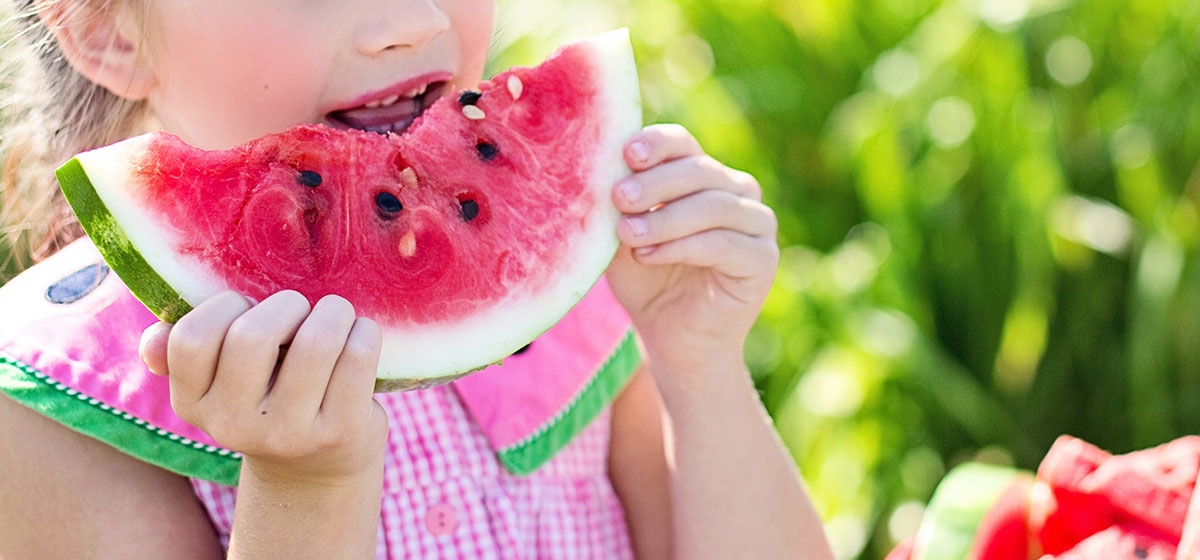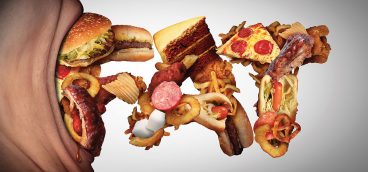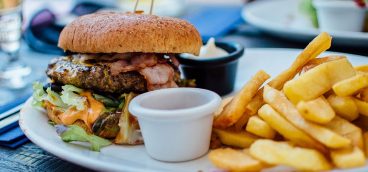
Despite a large selection of best-selling diet books and an abundance of low-fat and non-fat foods, the latest data from the Centers of Disease Control (CDC) shows that Americans are heavier than ever before. We spend more than $60 billion annually on diet and weight loss products yet four in 10 adults, over 90 million men and women, are clinically classified as obese. According to the New England Journal of Medicine (July 2017) we also have the highest level of obesity in children and young adults among the world’s 20 largest countries. The health risks associated with obesity are well documented: heart disease, stroke, high blood pressure, diabetes, joint problems and even some forms of cancer. In most cases these risk factors establish roots in childhood.
The percentage of young people who are overweight has more than tripled since the 1970’s with a third of children age two to 19 overweight or at risk of becoming overweight. Studies suggest that children who are overweight are much more likely than children of normal weight to become overweight or obese adults. These findings have far reaching implications. Though many parents view baby fat as simply a normal phase in their child’s life, for many children it represents the beginning of a lifelong struggle with obesity.
What is the solution? Dieting is not the answer, particularly for kids. A significant reduction of calorie intake can result in children not getting enough essential nutrients necessary for growth and optimal health. Diets simply do not work for kids (as well as adults) over the long term. Follow-up surveys show that the vast majority of people, more than 95%, who initially lose weight on a diet eventually gain all or even more of it back. The actual cause, as well as the cure, of the overweight condition is grounded in the eating and activity behaviors that we perform day-in and day-out: our habits. Most unhealthy habits begin innocently and unwittingly with our choices of food and drink, how we prepare foods, what toppings we put on foods, how we spend our leisure time, and if, when and how often we are physically active. Each time we repeat a behavior, it is strengthened and eventually becomes a habit. For better or worse, we often become slaves to our habits. We become what we repeatedly do.
The Basics of Weight Gain
Weight gain (and loss) is purely a matter of energy imbalance. When you consume more calories (energy) from foods and beverages than the body requires for healthy functioning, growth, and physical activity, it will lead to extra weight gain over time. The excess calories are stored as fat. Consuming 3,500 calories above and beyond energy expenditure, whether the excess occurs over a period of days, weeks, or even months, results in the deposition of one pound of body fat. The process works just as effectively in reverse, and therein is the key to losing weight and keeping it off. A single behavior that eliminates 100 calories a day (or burns an additional 100 calories) will result in a calorie deficit of about 35,000 calories over the course of a year, or a fat loss of approximately 10 pounds.
Eliminating 100 calories a day can be accomplished simply by replacing a large glass of whole (4% fat) milk with 1% milk, by replacing the usual breakfast donut with an English muffin and fruit spread, or by choosing a bottle of water rather than a can of soda. Likewise, walking for 20 minutes, the distance of about one mile, can burn approximately 80–100 calories depending on body weight. Minor changes in eating and activity habits can result in major changes over time. The key to permanent weight loss is to replace habits that work against you with habits that work for you. Attempting to eliminate behaviors entirely, particularly when dealing with children (no sweets, no carbs, no pizza), typically doesn’t work over the long haul.
There are a number of subtle behavior changes that children can make to reduce calorie intake without sacrificing portion size, variety, or taste, and at the same time increase the number of calories burned each day. Adopting the “Slimming Strategies” that follow will promote fat loss in kids and provide a framework for healthy family eating.
Slimming Strategies
Analyze your child’s eating and activity behaviors and determine where subtle changes will make a difference. Consider the following:
#1. Eliminate liquid calories.
This should be the starting point for most people. Kids can easily cut calories with just a few minor changes in what they drink. An 8-ounce glass of soda, orange juice, or energy drink all contain significant amounts of sugar. Whole milk (4 % fat) and milkshakes contain substantially more fat than alternatives like low-fat milk and yogurt. As a rule of thumb, choose lower calories alternatives like unsweetened team, bottled water and occasionally diet drinks. If you must drink fruit juice, dilute it with water to reduce the calorie and sugar intake. Regular soda really has no place in a healthy child’s diet. The mix of sugar, artificial color and flavor, preservatives, and chemicals provide no nutritional value whatsoever – only extra calories. Soda pop is okay every so often, but not on a regular basis.
#2. Make smart food choices.
The goal here is to cut calories without eliminating any types of food, or even the quantity of food eaten. Replace high calorie foods with lower calorie alternatives. For example, choose fresh versus canned fruit which is loaded with sugar, unbuttered versus buttered popcorn, steamed versus fried veggies, pretzels versus potato chips, egg whites verses egg yolks, and low-fat yogurt versus ice cream. There is no need to eliminate any type of food or food group. Be creative!
#3. Choose your condiments wisely.
What we put on foods often transforms the meal from a healthy low-calorie dish to a high-calorie entrée. This is one area where we can easily reduce the number of calories consumed without sacrificing amounts of food eaten. High calorie high-fat toppings include butter, margarine, gravy, mayonnaise, creamy salad dressing, cheese, and sour crème. Lower calorie alternatives such as light margarine, mustard, ketchup, vinegar and oil dressing, marinara, and low-cal mayonnaise will reduce calories substantially.
#4. Heart healthy preparation
How we prepare foods can significantly impact the calorie count of a meal. Baking is recommended over frying to reduce calories and is healthier as well. A baked, broiled, or boiled potato contains approximately 150 to 200 calories. That same potato, when cut into strips and prepared as French fries, has three times the number of calories, mainly due to the frying oil. Baking, broiling, steaming, and grilling are your best choices for preparing vegetables, poultry, red meat, and fish.
#5. Remove skin from poultry and trim fat from red meat.
Trim the visible fat from beef and pork. Remove the skin, which contains the most fat and calories, from baked chicken. Choose tuna canned in water rather than oil, and use low-fat or non-fat cooking sprays that will cut calories. Limit the consumption of high fat processed meats like hotdogs and salami.
#6. Don’t ride when you can walk
Walking is an excellent form of physical activity that strengthens bones, improves cardiovascular function, and burns calories. The National Association of Sport and Physical Education (NASPA) recommends that children five to 12 years of age get at least 60 minutes, and preferably more, of moderately intense physical activity every day of the week. That is sometimes a tall order for kids in today’s highly mechanized society. When walking is a reasonable and safe choice it is good practice for kids to walk rather than ride – unless they are riding a bike! Adding just 1,000 steps to their daily travels (10 minutes of walking), a distance equivalent to about ½ of a mile, can burn 40 to 50 calories. The extra energy expenditure when performed daily translates into a 5-pound weigh loss over the course of a year.
#7. Practice functional fitness.
Kids can burn a substantial number of calories through “functional fitness,” normal everyday physical activity that achieves an objective above and beyond simply burning calories. For example, any one of the following activities can burn 75 to 100 calories depending upon the child’s body weight and intensity of the activity.
- Trimming bushes for 20 minutes
- Shoveling snow for 20 minutes
- Raking leaves for 20 minutes
- Mowing the lawn for 20 minutes
- Washing the car… and there are many more possibilities.
While most kids might not list these as their favorite activities, they are necessary activities. Kids can help with the chores and gain the secondary benefit of burning additional calories which helps to maintain a healthy body weight.
When a child adopts even a few of the strategies we’ve discussed, they will begin to cut a significant number of calories each day, while at the same time increasing calories burned through additional physical activity. The first step is to analyze your child’s eating and activity habits and then make subtle adjustments that will work in his or her favor. Always keep in mind that the calorie-cutting effects of a healthy low-fat diet coupled with the calorie-burning effects of regular physical activity are cumulative. Cutting 50 calories here and burning 75 calories there, if done on a regular basis, will result in significant weight loss and improved wellness over time. This is the safest and surest method successfully combating the epidemic of childhood obesity facing American children.




